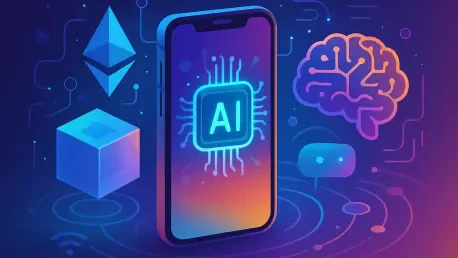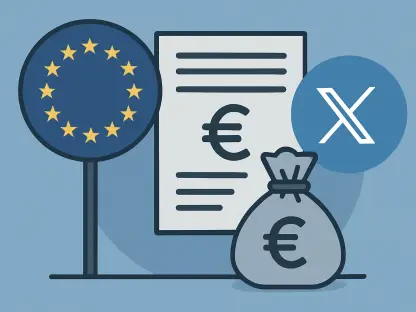In an era where mobile apps have become integral to daily life, a groundbreaking transformation is unfolding as artificial intelligence (AI) and Web3 technologies merge to redefine the digital landscape. This powerful convergence promises to create applications that not only predict user needs with uncanny accuracy but also empower individuals through decentralized control over their data. Imagine a world where your smartphone app tailors itself to your preferences in real-time while ensuring your personal information remains secure and under your ownership. This fusion is set to reshape how developers build apps, how businesses generate revenue, and how users interact with technology. As this revolution gains momentum, it brings with it a mix of thrilling opportunities and complex challenges, from enhancing personalization to navigating privacy regulations. This exploration delves into the profound impact of AI and Web3 on mobile apps, uncovering the trends, innovations, and hurdles that will define the future of digital experiences.
AI at the Heart of Mobile Innovation
The role of AI in mobile app development has evolved from a mere enhancement to a fundamental pillar that drives smarter, more responsive user experiences. By integrating AI-first architectures, apps are now capable of adapting interfaces dynamically and offering predictive features directly on the device. This means functionalities like real-time language translation or predictive text input can operate without constant cloud connectivity, significantly reducing latency and enhancing user privacy. Such advancements allow for a seamless experience where the app feels like an intuitive extension of the user, anticipating needs before they are even articulated. Industry discussions highlight the potential of local AI assistants to customize interfaces instantly, challenging conventional app store distribution models by prioritizing direct, personalized engagement.
Beyond personalization, AI’s integration into mobile apps is streamlining operational efficiency in ways previously unimaginable. On-device machine learning minimizes the need for data transmission, addressing both speed and security concerns in a single stroke. This approach not only cuts down on bandwidth usage but also ensures sensitive information stays local, a critical factor as data privacy becomes a top concern. Moreover, AI-driven analytics enable developers to gain deeper insights into user behavior without compromising individual anonymity, paving the way for more informed design decisions. As these technologies mature, they are expected to redefine the benchmarks for app performance, pushing the industry toward a future where adaptability and efficiency are not just features but standard expectations in every mobile interaction.
Web3 and the Shift to Decentralization
Parallel to AI’s rise, Web3 is ushering in a decentralized paradigm for mobile apps through the power of blockchain technology. This shift empowers users by granting them ownership over their data, a stark contrast to the centralized models dominating today’s digital ecosystem. With Web3, mobile apps can incorporate features like non-fungible tokens (NFTs), smart contracts, and token-based economies to foster engagement and create new revenue streams. Early examples include platforms experimenting with gamified reputation systems, where users earn rewards for participation, illustrating how transparency and trust can redefine digital interactions. Yet, challenges persist, particularly in scaling these decentralized systems to handle mass adoption while maintaining clarity in privacy-focused applications.
The promise of Web3 extends beyond user empowerment to fundamentally altering how trust is built within mobile ecosystems. Blockchain’s immutable nature ensures that transactions and data exchanges are transparent and verifiable, reducing reliance on intermediaries and enhancing security. This is particularly transformative for industries like finance or social networking, where trust is paramount. However, integrating these systems into mobile apps requires overcoming significant technical barriers, including energy consumption and transaction speed, which can hinder user experience if not addressed. As solutions emerge, such as layer-2 protocols on networks like Ethereum, the vision of a decentralized app landscape becomes more tangible, setting the stage for a future where users wield unprecedented control over their digital presence.
Privacy in the Age of Advanced Tech
As AI and Web3 technologies advance, privacy emerges as a cornerstone issue that developers must prioritize to maintain user trust and comply with global standards. Stringent regulations like GDPR are shaping the mobile app landscape, mandating that privacy be embedded into the design process from the outset. This means developers must adopt a privacy-by-design approach when integrating AI algorithms and blockchain systems, ensuring that user data is protected against breaches and misuse. Failure to adhere to these standards can result in severe penalties, making compliance a non-negotiable aspect of app development. Emerging innovations, such as anonymous yet verifiable transaction methods, are gaining attention as viable ways to balance functionality with regulatory demands.
Navigating the fragmented regulatory environment poses a unique challenge for developers working with AI and Web3 integrations. Different regions enforce varying rules, creating a complex web of requirements that can stifle innovation if not managed strategically. Beyond legal compliance, there is a growing user expectation for transparency in how data is handled, especially as AI systems process vast amounts of personal information to deliver tailored experiences. Blockchain’s decentralized nature offers a potential solution by allowing users to track and control their data, but it must be paired with robust encryption to prevent vulnerabilities. As the industry moves forward, striking a balance between cutting-edge features and stringent privacy safeguards will be critical to fostering confidence in this new wave of mobile applications.
Overcoming Development Obstacles
Integrating AI and Web3 into mobile apps comes with a steep price tag and a pressing need for specialized expertise, creating significant barriers for many developers. The financial burden of adopting these technologies can be daunting, especially for smaller teams or startups looking to compete in a crowded market. Additionally, the scarcity of talent proficient in both AI and blockchain development exacerbates the challenge, often leading to delays and increased costs. However, solutions are emerging to mitigate these issues, such as cross-platform frameworks like Flutter and React Native, which streamline development across multiple devices while reducing expenses. These tools enable faster time-to-market, allowing developers to focus on innovation rather than repetitive coding tasks.
Beyond cost and talent concerns, there is a growing emphasis on sustainable practices within the mobile app development sphere to align with broader environmental goals. Techniques like DevSecOps are being adopted to integrate security and efficiency into the development pipeline, ensuring that apps are both robust and resource-conscious. Meanwhile, edge computing offers a way to process data closer to the user, minimizing energy-intensive cloud interactions. Sustainable coding practices are also gaining traction, encouraging developers to optimize algorithms for lower power consumption. Addressing these development hurdles requires a multifaceted approach, blending technological innovation with strategic planning to ensure that the benefits of AI and Web3 are realized without compromising on feasibility or ecological responsibility.
Industry Transformations Through Fusion
The real-world implications of combining AI and Web3 in mobile apps are profound, with the potential to revolutionize sectors ranging from healthcare to education. Consider health applications that leverage AI for personalized treatment plans while using blockchain to securely share patient data among providers, ensuring both accuracy and confidentiality. Similarly, in e-commerce, augmented reality (AR) powered by AI can create immersive shopping experiences, while Web3’s decentralized frameworks enable secure, transparent transactions. These examples underscore the transformative capacity of this technological synergy, offering tailored solutions that enhance user engagement and trust across diverse fields, setting a new standard for what mobile apps can achieve.
Looking further, the rise of decentralized applications (dApps) signals a shift toward self-sustaining digital ecosystems that prioritize user autonomy and privacy. Advanced privacy technologies, such as multi-party computation, are being integrated to protect data even within collaborative environments, ensuring that sensitive information remains secure. In education, AI-driven apps can adapt learning content to individual student needs, while Web3 ensures that credentials and achievements are stored immutably on the blockchain, preventing fraud. These use cases highlight a future where mobile apps do more than entertain or inform—they solve critical challenges and empower users in unprecedented ways, paving the way for broader societal impact through thoughtful technological integration.
Charting the Path Ahead
Reflecting on the journey, the integration of AI and Web3 has reshaped mobile apps into tools that are smarter, more secure, and deeply user-focused. This synergy delivers personalized experiences through AI’s on-device intelligence, while Web3’s decentralized models ensure users retain control over their digital identities. Despite the hurdles of regulatory compliance, technical complexity, and economic constraints, the industry has adapted by embracing innovative strategies like cross-platform development and privacy-first designs. Moving forward, developers should prioritize scalable solutions and continue to refine privacy safeguards to sustain trust. Collaboration between tech leaders and policymakers will be essential to harmonize regulations and foster an environment where innovation thrives. As the next steps unfold, focusing on sustainable practices and accessible tools will ensure that the benefits of this technological fusion reach a global audience, solidifying mobile apps as indispensable pillars of modern life.









